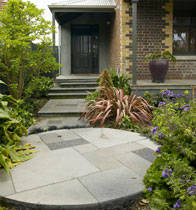Concrete

Concrete tanks have been used in rural areas for many years but are becoming more common in the city, particularly pre-cast underground concrete tanks that can be placed under driveways or front and back yards. The advantage of underground concrete tanks is that they can collect large volumes of water in properties tight for space that could not otherwise accommodate above-ground tanks. Houses with small gardens still consume large volumes of water internally through laundries, toilets and showers and could benefit from using underground concrete tanks for 'whole of house' water supply.
Cost:
The actual pre-cast concrete tank itself is generally only slightly more expensive than some steel options, however it becomes more expensive per litre when placing concrete tanks underground as excavation, transport and crane hire (for larger tanks) can be quite expensive. However, with rising land and water prices it may be a wise long-term investment for inner-city and small blocks, as an underground tank does not take up any valuable space on the property.
Please see the Price Comparison for price estimates.
Deterioration/life span/durability:
Concrete tanks are extremely durable and most purpose-built concrete rainwater tanks have plasticisers added for strength and are poured into a seamless mould to prevent leaks. Most manufacturers offer warranties of between 20 and 30 years, however a good quality concrete tank can last several decades.
While not as easy to repair as steel or fibreglass tanks, leaking concrete tanks can be fixed with various sealants depending on the size of the crack and the position.
Sizes and shapes:
There are more and more companies producing pre-cast concrete tanks in many shapes and sizes including rectangular ones that fit neatly under driveways. Underground concrete tanks can also be cast on site (in situ). Most concrete tanks, whether pre-cast or built on site, are designed to be load bearing and are therefore ideal for placing under driveways.
Water quality:
Some older concrete tanks may leach lime, increasing the pH of water and affecting its taste. However, in most cases the water quality from concrete tanks is very good. Concrete tanks tend to keep the water cooler than most other tanks, reducing the likelihood of bacterial growth.
Environmental credentials:
Concrete tanks have high embodied energy, however a good quality concrete tank will have a long life-span and can be recycled at the end of its life.
Site preparation:
Concrete tanks are extremely heavy and therefore some settling tends to occur once put in place. The use of packing sand or cracker dust is recommended and it may be worth rolling or compacting the sand before installing the tank to reduce initial movement. It is advisable to allow the tank to settle for a number of weeks before connecting fixed plumbing.
Two of the concrete tanks (50,000L each) were installed in 1924 and are still giving faultless service.
Concrete tanks for house water chosen for health reasons. Small concrete tank developed some cracking and weeping, now self sealed. That was 10 years ago.
Slight weeping on settling of above-ground tank but repaired by three hands full of cement thrown in at the stage of inflow reaching this level. Not used for two months after treatment. Water quality good.